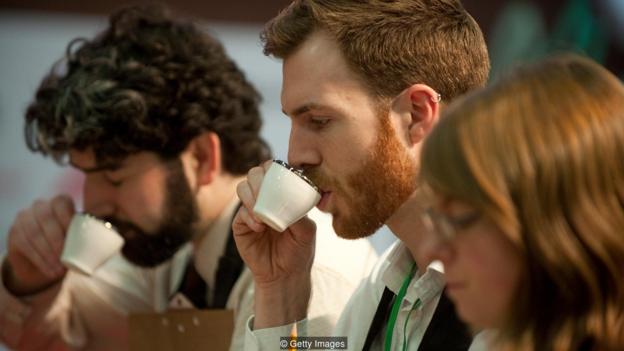The disease that could change coffee

If you landed in Bogota in the 1960s, one of the first things you would have probably seen outside the airport was a giant billboard. In a slightly menacing tone, it said: “Coffee rust is the enemy. Don’t bring plant materials from abroad”.
It was one of the first warnings about a foe that has been threatening Colombia’s coffee trade ever since.
Coffee rust is a disease with the power to cripple, or even wipe out, the country’s national product, the base of one of its biggest industries, and one of its most important sources of foreign currency. Last year alone, its coffee exports were worth $2.4bn (£1.8bn), and were 7.7% of all goods the country sold overseas. That makes Colombia the third largest producer of coffee in the world. In other words, if rust takes hold there and global supply dwindles, it will affect the price of the coffee we drink everywhere.
That’s why for the past few decades, Colombia’s scientists have been engaged in a little-known battle with the disease, staged from a small laboratory deep inside the mountains of Colombia’s coffee axis.
Coffee rust has plagued farmers for more than a century. When a tree gets infected by it, its leaves produce a brown, thin powder when scratched, pretty much like iron rust. The disease, caused by the fungus Hemileia vastatrix, also de-colours the bush’s leaves from a bright green to a brownish yellow. In the end, the tree loses all its leaves, as well as its ability to produce beans.
If left unattended, the disease can have dramatic consequences. In the late 19th Century, Sri Lanka, the Philippines, and other countries in Southeast Asia were the major exporters of coffee in the world. In a matter of decades, the disease meant they practically stopped growing it.
Historians suggest that this is part of the reason why Britons prefer tea nowadays. “Sri Lanka moved over to tea production” since coffee was no longer profitable, explains Aaron Davis, head of coffee research at Royal Botanic Gardens, Kew. Luckily for Asian producers, Britain was eager to switch its taste when their coffee supply vanished.
Beauty vs beast
What makes coffee rust a particular worry for Colombia is that it attacks the type of coffee that the country relies on – and that coffee lovers have got used to drinking.
Coffee comes in two varieties. We could call them ‘the beauty’ and ‘the beast’.
‘The beauty’ is Coffea arabica. Its seed gives a delicious and delicate brew that sells at good prices in international markets. This is the variety that made Colombian coffee so famous.
‘The beast’ is Coffea canephora, also known as robusta. It is a tougher tree, with more resistant leaves, that is cheaper to grow and crop. It has a more rough and bitter taste; not very appealing for coffee connoisseurs and not as appreciated by the market as its gentler brother. As a result, it accounts only for a 37% of the world coffee production, according to the International Coffee Organisation.
Unfortunately, coffee rust attacks the ‘beauty’, but not the ‘beast’. Colombia only exports ‘beauties’, so switching has never been an option.
In the 1960s, a team of scientists at a research laboratory called Cenicafe set out to find a solution that drew on the best features of the two varieties – but it wouldn’t be straightforward.
The laboratory
To get to Cenicafe, you have to drive all the way to the top of a mountain; the twisting roads can make you sick if you are not used to them. The lab is nested there to keep its 89-year-worth body of research away from the force of nature: the prior building flooded after a volcano eruption in 1985.
It was set up by the Colombia’s National Federation of Coffee Growers (also known as Fedecafe), the coffee industry association in the country, and is considered a global flagship centre for the science of coffee.
“Cenicafe is what has allowed us to remain competitive and lower our risk”, explains Hernando Duque, technical director of Fedecafe. Its research helped domesticate and make viable many of the high-quality varieties that the country grows and the world enjoys.
Today, the laboratory’s work is regarded as the gold standard in the fight against “the most acute threat against coffee in the Americas”, says Michael Sheridan, director of sourcing and shared value at Intelligentsia Coffee Roasters, a specialty coffee importer in the US.